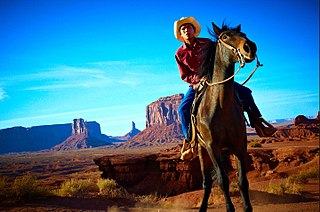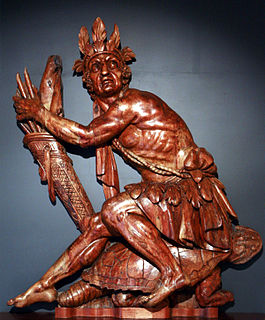This article needs additional citations for verification .(January 2011) (Learn how and when to remove this template message) |
Gaoh is the "Spirit of the Winds" in the Algonquian language.
A spirit is a supernatural being, often, but not exclusively, a non-physical entity; such as a ghost, fairy, or angel. The concepts of a person's spirit and soul, often also overlap, as both are either contrasted with or given ontological priority over the body and both are believed to survive bodily death in some religions, and "spirit" can also have the sense of "ghost", i.e. a manifestation of the spirit of a deceased person. In English Bibles, "the Spirit", specifically denotes the Holy Spirit.

The Algonquian languages are a subfamily of Native American languages which includes most of the languages in the Algic language family. The name of the Algonquian language family is distinguished from the orthographically similar Algonquin dialect of the indigenous Ojibwe language (Chippewa), which is a senior member of the Algonquian language family. The term "Algonquin" has been suggested to derive from the Maliseet word elakómkwik, "they are our relatives/allies". A number of Algonquian languages, like many other Native American languages, are now extinct.
Ga-oh is the Spirit of the Winds. He moves the winds, but he is chained to a rock. The winds trouble him, and he tries very hard to get free. When he struggles the winds are forced away from him, and they blow upon the earth. Sometimes he suffers terrible pain, and then his struggles are violent. This makes the winds wild, and they do damage on the earth. Then he feels better and goes to sleep, and the winds become quiet also. [1]
Native Americans, including the Massachusett, Nipmuc, Wampanoag and other Algonquian peoples, maintained a different relationship to nature. A common perception of indigenous peoples throughout the world is that nature (in its many forms, including the wind, climate and weather) is imbued with power over the human world, higher power, mysterious in origin, and deserving of worship.

The Algonquian are one of the most populous and widespread North American native language groups. Today, thousands of individuals identify with various Algonquian peoples. Historically, the peoples were prominent along the Atlantic Coast and into the interior along the Saint Lawrence River and around the Great Lakes. This grouping consists of the peoples who speak Algonquian languages.

Nature, in the broadest sense, is the natural, physical, or material world or universe. "Nature" can refer to the phenomena of the physical world, and also to life in general. The study of nature is a large, if not the only, part of science. Although humans are part of nature, human activity is often understood as a separate category from other natural phenomena.

Indigenous peoples, also known as first peoples, aboriginal peoples or native peoples, are ethnic groups who are the original settlers of a given region, in contrast to groups that have settled, occupied or colonized the area more recently. Groups are usually described as indigenous when they maintain traditions or other aspects of an early culture that is associated with a given region. Not all indigenous peoples share this characteristic, as many have adopted substantial elements of a colonizing culture, such as dress, religion or language. Indigenous peoples may be settled in a given region (sedentary) or exhibit a nomadic lifestyle across a large territory, but they are generally historically associated with a specific territory on which they depend. Indigenous societies are found in every inhabited climate zone and continent of the world.











